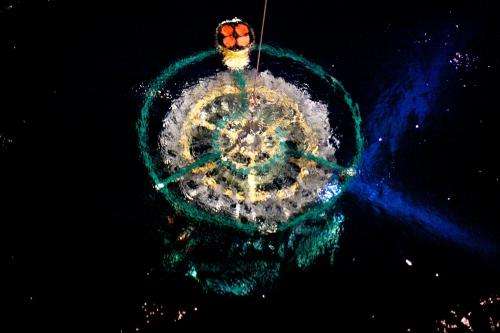CTD oceanography instrument used by researchers from the Malaspina Expedition. Credit: CSIC / JOAN COSTA
Researchers from the Malaspina Expedition have made strides in the understanding of the mechanisms governing the persistence of dissolved organic carbon (DOC) for hundreds or thousands of years in the deep ocean. Most of this material is below 1,000 meters deep, but it is not degraded by bacteria. Until now, it was thought that it consisted of non-degradable chemical compounds, but this study shows that it actually comprises very low concentrations of thousands of readily degradable compounds. The finding, published in the latest issue of the Science journal, provides new keys to further deepen the understanding of the regulation of the carbon cycle and the global climate.
The ocean contains an enormous amount of carbon in the form of dissolved organic matter. Its volume, about 700 billion kilograms, is comparable to all the carbon dioxide accumulated in the atmosphere, or more than 200 times greater than the sum of all the carbon contained in marine organisms.
Jesus Maria Arrieta, researcher from the Malaspina Expedition, states: "It is estimated that between 30% and 50% of the production of organic matter from the ocean, which, in turn, is half the production of the global organic matter, is released in the form of DOC in the ocean. Recognizing the mechanisms that enable this dissolved organic material to be persistent in the deep ocean is crucial to understand the regulation of the carbon cycle and the global climate".
The circumnavigation, performed by the Hesperides vessel as part of the Malaspina project, was a unique opportunity to obtain samples from the Atlantic and Pacific oceans. For this study, scientists have used samples of dissolved organic material from the deep ocean obtained at different depths between 1,000 and 4,000 meters.
Up to present, it was thought that this organic material dissolved in the deep ocean was resistant to microbial degradation as it consists of recalcitrant or highly resistant chemical structures. According to this new study, if bacteria can not cope with the thousands of different molecules that make up the carbon is because they are found in a very low concentration. The expenditure of energy by bacteria to use each of these molecules can not be compensated by the low concentration available, which prevents its degradation.
CSIC researcher emphasizes: "By offering concentrated organic material from the deep water to bacteria, we have observed a stimulation of growth at higher concentrations, i.e., this organic material from the deep ocean, hitherto considered to be little or not degradable at all, is actually readily degradable for the deep-ocean microorganisms. The reason is that this large amount of organic carbon is a mixture of "leftovers" from easily degradable materials, but their use is limited by the existing low concentrations of each compound".
Mechanisms governing the climate
According to previous studies, an increase in the concentration of DOC in the deep ocean in the past might have entailed a removal of CO2 from the atmosphere and a cooling effect on the planet. Arrieta adds: "It has been recently proposed to attempt to promote the microbial production of recalcitrant natural compounds in order to sequester carbon dioxide from the atmosphere and store it in the ocean. Our work indicates that the potential of this proposal would be very limited".
Journal information: Science
Provided by Spanish National Research Council
























